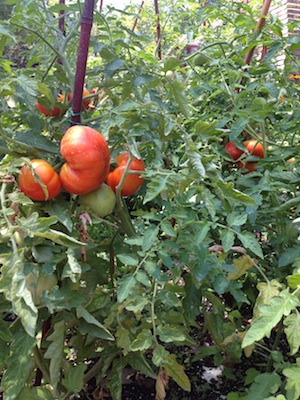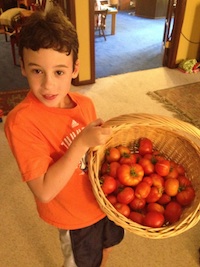By Joyce Affeldt
This month, Family Eats will start reaching out to our readership, asking them to share their experiences with reconnecting with the food they eat and the families they love. It is our way of bringing different family perspectives to Family Eats. We can give you the low-down on the family with young kids, but what about the Millenials, Empty Nesters and everyone in between? For this post, we turn to Mom (she’s of the Boomer/Empty Nester category ;-)), who talks about readying the vegetable garden.
Springtime in Northeast Ohio is a nebulous time. Sometimes it begins in mid-March—more often, it begins in late April. We have noticed the harbingers of spring—birds, chipmunks, squirrels—as we drink our morning coffee, looking out through the French doors onto the patio and garden beyond. The birds hover over the feeders, as the squirrels on the trees above look down and ponder their plan of action to partake in the contents of the feeders. This is a time of excitement for us of the coming months, even though the snow still manages to sneak around a couple of times yet before we can really call it spring.
 Each year, we look forward to the gardening seminars held at our local garden center in early March. This year, the first session was on planting seeds. Last year, Richard (my husband) set up a grow-light above his myriad of seedlings. He grew so many tomato and red pepper seeds that we had to find a lot of room for all of them when they were ready to plant. He couldn’t bear to get rid of any of them, so we planted in the ground, in large pots, in spaces he was able to find amongst the flowers. At the end of the summer, we had eaten so many tomatoes, tomato products, etc. and filled two refrigerator freezers.
Each year, we look forward to the gardening seminars held at our local garden center in early March. This year, the first session was on planting seeds. Last year, Richard (my husband) set up a grow-light above his myriad of seedlings. He grew so many tomato and red pepper seeds that we had to find a lot of room for all of them when they were ready to plant. He couldn’t bear to get rid of any of them, so we planted in the ground, in large pots, in spaces he was able to find amongst the flowers. At the end of the summer, we had eaten so many tomatoes, tomato products, etc. and filled two refrigerator freezers.
This year, he conceded that forty tomato plants were a bit too much for two people—especially since our family all live in other states. After that first seminar on planting seeds, he only bought a few packages of seeds (which really surprised me)!
This past weekend, the seminar was about vegetable gardening. Now, it’s really time to get serious. We listened carefully, and realized that all we had been doing wasn’t necessarily the best way to do things. Since our backyard is primarily flower beds, the tomatoes and peppers were grown in large pots scattered around our swimming pool. We found this good for the plants, but not ideal for safety around the pool area. Last year, we made some room in our garden and many of our plantings were made directly into the soil. We did, however, have to resort to several pots since there were so many plants.
Some of the things we learned at the garden center seminar were that heirloom plants are not disease-resistant. The heirloom tomatoes – Casellotta Genovese – go back about 250 years; Brandywine Red is the best tasting.
Our instructor encouraged everyone to find space to garden—if not directly in the ground, then container planting is very successful. We found this to be true in our yard. Some other ideas were raised beds, a hollowed out bale of hay filled with topsoil, and a vertical garden. He has made a tepee out of concrete reinforcing wire and placed it either in the ground or a large pot. It is also a good idea to site your vegetable garden close to the kitchen so that you always have easy access to fresh vegetables and herbs.
We learned about a natural weed control formula: Mix one gallon of white vinegar with a squirt of liquid dish detergent; for a fungicide: Mix one gallon of water, 1 tablespoon of baking soda and a squirt of liquid dish detergent. Spray on plants once a week or every ten days. Crush eggshells or use bone meal around tomato plants.
Our vegetable gardening is not too extensive—just tomatoes, peppers, a few cucumbers, and a small amount of lettuce.  Along with all the herbs that we plant, there is enough there for us to experiment with new recipes. Last year, I tried a stuffed pepper soup, using our fresh tomatoes and peppers. It was delicious! I’m already going through my collection of recipes to find something different, something new that I’ve not yet tried, to round out the standard recipes that I will use. Our favorite use for fresh tomatoes is to slice them, slice cucumbers, red onion and mozzarella cheese and alternately place them on a salad plate. Drizzle with olive oil and top with fresh basil (from the garden, of course).
Along with all the herbs that we plant, there is enough there for us to experiment with new recipes. Last year, I tried a stuffed pepper soup, using our fresh tomatoes and peppers. It was delicious! I’m already going through my collection of recipes to find something different, something new that I’ve not yet tried, to round out the standard recipes that I will use. Our favorite use for fresh tomatoes is to slice them, slice cucumbers, red onion and mozzarella cheese and alternately place them on a salad plate. Drizzle with olive oil and top with fresh basil (from the garden, of course).
The joy of using our bounty of fresh vegetables every day gives us a sense of accomplishment. But first, I must go through the freezer to see what might still be left from last summer! There surely will be enough growing this summer, as long as the raccoons, squirrels, chipmunks and ground hogs don’t get too enticed.






